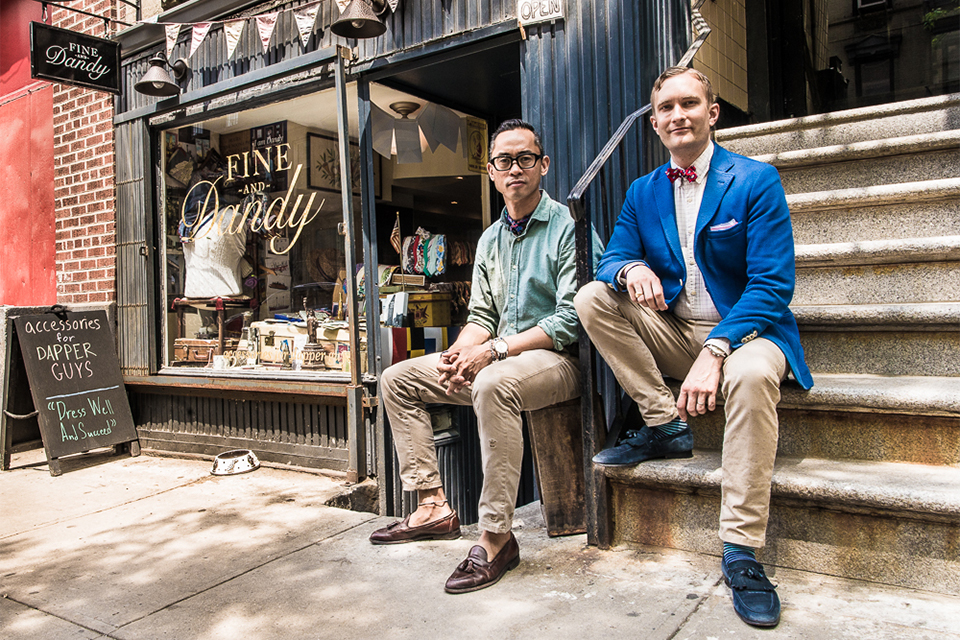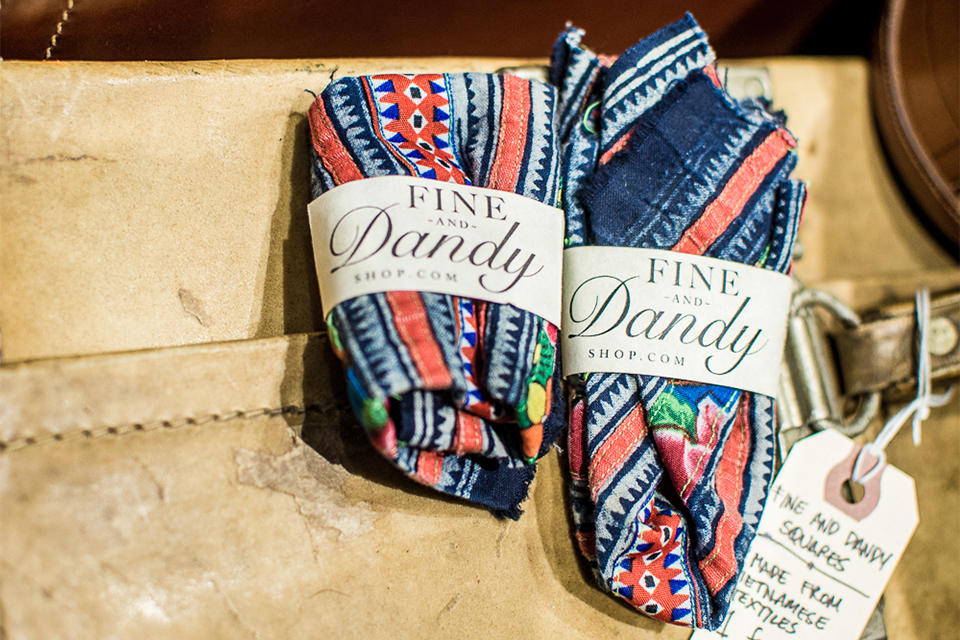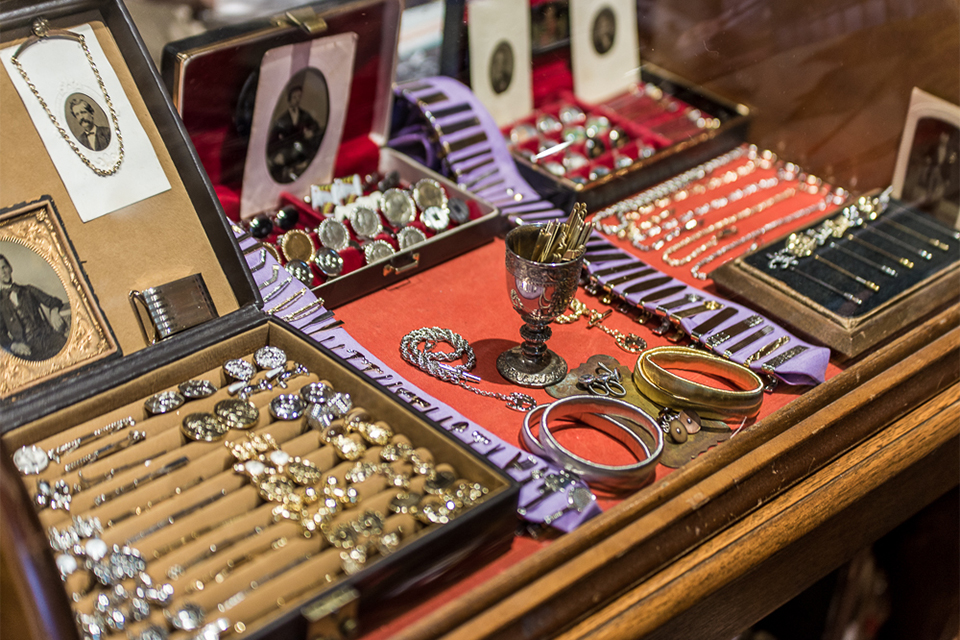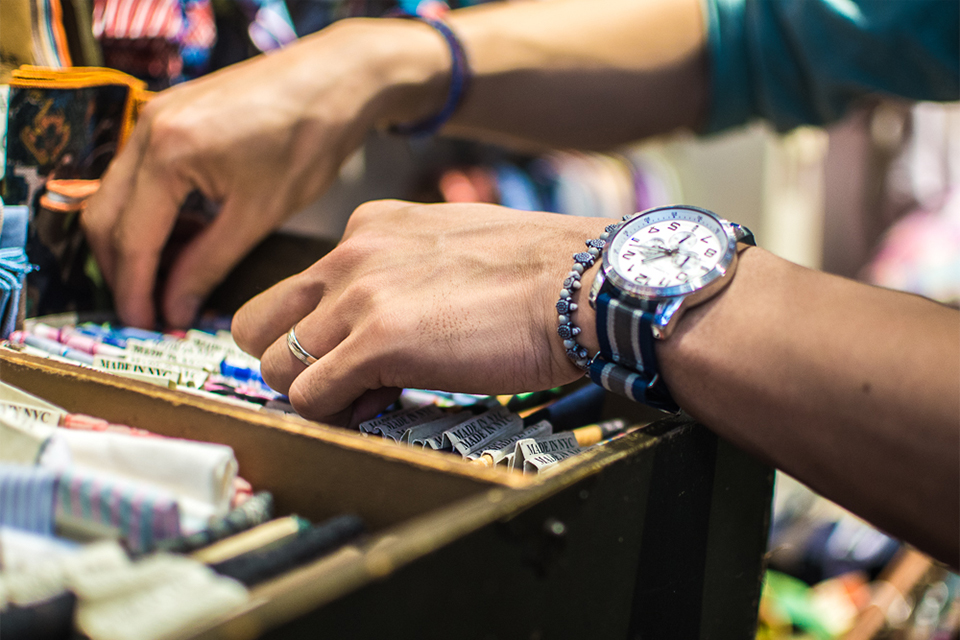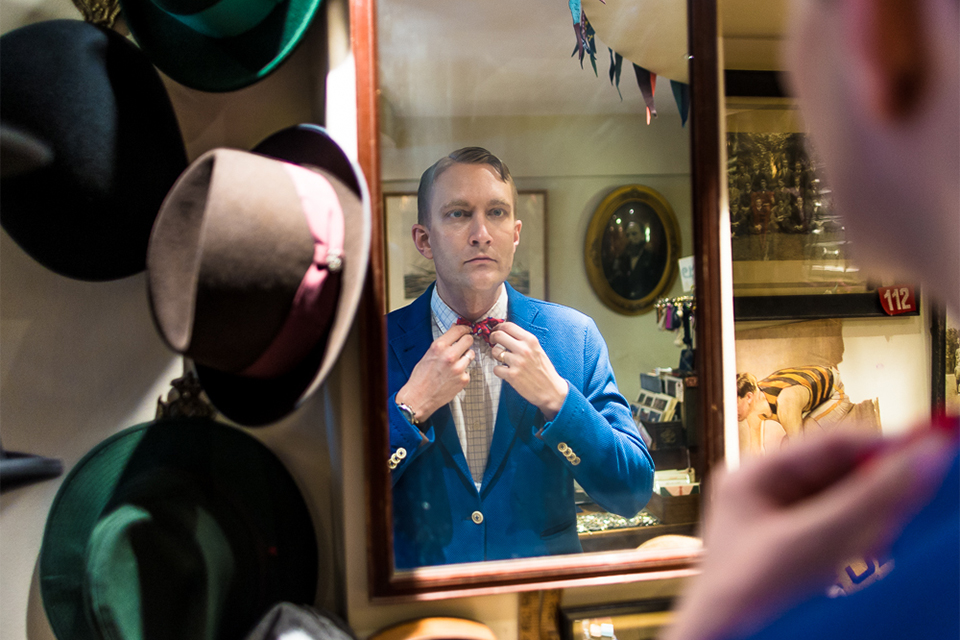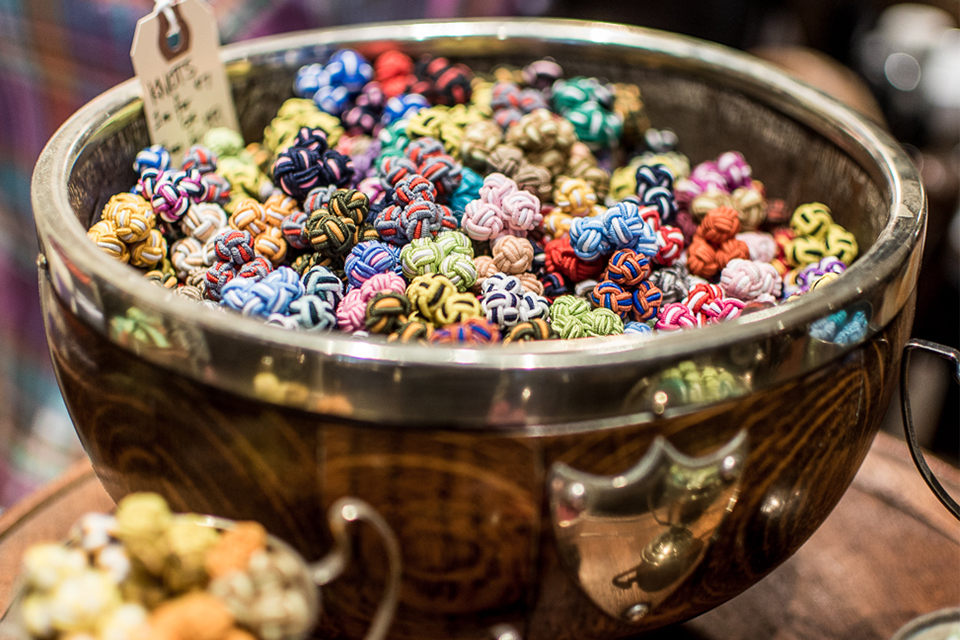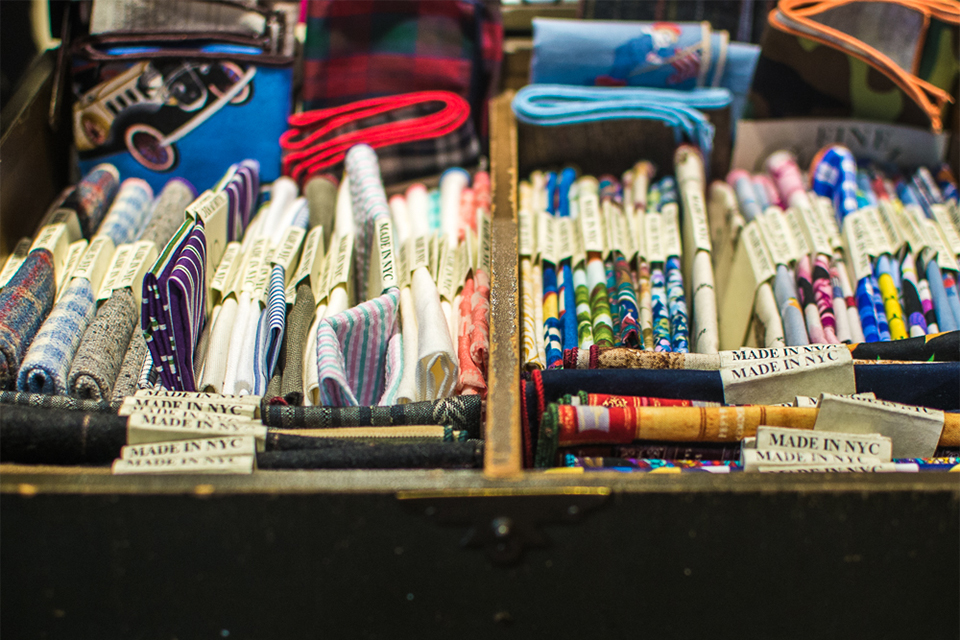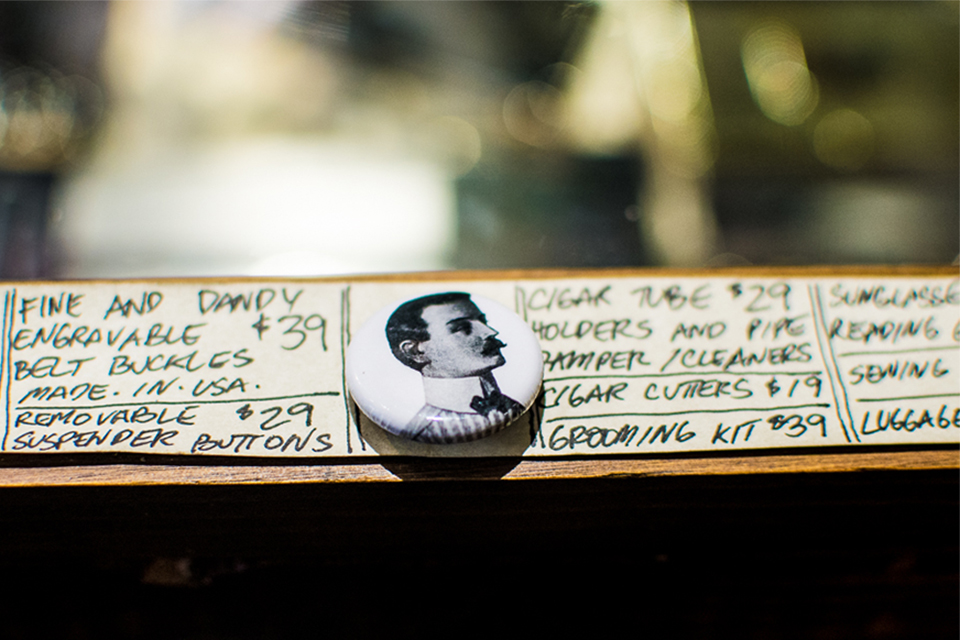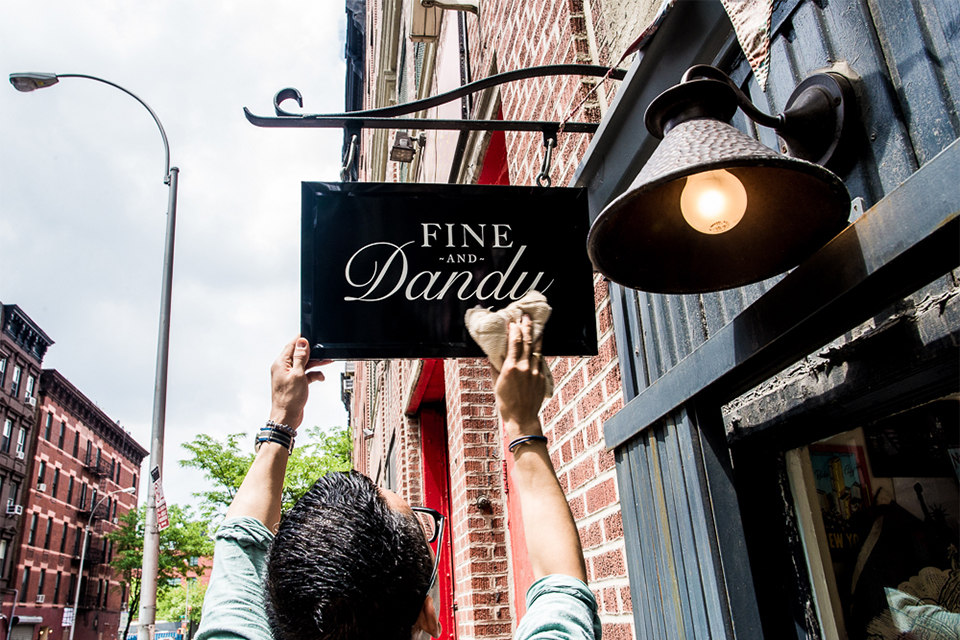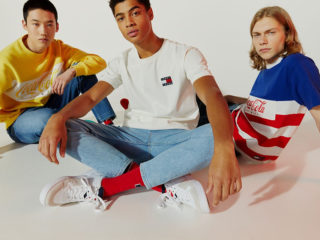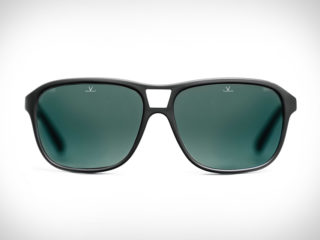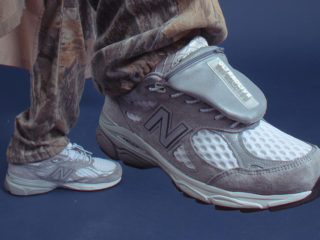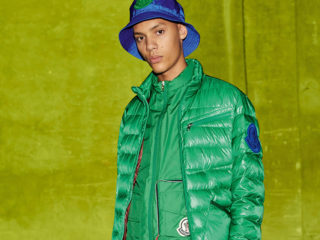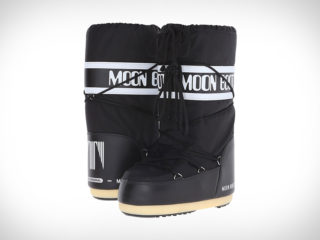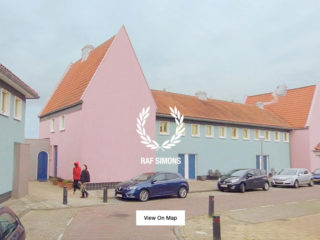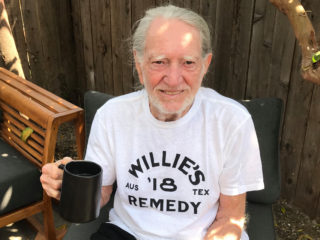Over the last five years, men’s fashion has undergone a major shift. From pocket squares and tie bars to undercut pomps and slicked-back hairdos, there’s obviously been a big push towards a more refined, more polished look. So we sat down with the owners of Fine and Dandy, an online and brick-and-mortar shop for men’s “dapper accessories,” to learn a little more about their business and get their take on the current state of menswear, fashion, and today’s modern-day gentleman.
So, first off, who are you guys?
Matt: Matt Fox
Enrique: Enrique Crame III
Matt And we’re the owners and founders of Fine and Dandy.
Fine and Dandy. What is that?
Matt: Fine and Dandy is a line of dandy-inspired men’s accessories. We have the brand, which we design and produce locally, and the shop, where about 80% of the items sold are our brand.
And why “Fine and Dandy”?
Matt: The word “dandy” kind of came up at one point, and we were like, “Oh, if we ever do something, it would be called dandy and…,” and then someone was like, “Fine and Dandy”, and we were like, “Yeah, that’s it!”
Enrique: Yeah, it’s one of those phrases that you kind of get right away. And it just sort of stuck with us.
And how long have you guys been around?
Matt: We first launched online about six-and-a-half years ago, and we’ve been here in Hell’s Kitchen for about two-and-a-half years. Honestly, when we launched online we both had other careers and it was just a hobby, a creative outlet really. We never thought we’d leave our careers and do this full time.
And what careers were those?
Matt: I was managing Broadway theaters.
Enrique: And I was in fashion retail working with Inditex for both Zara and Massimo Dutti brands.
So where did the idea behind Fine and Dandy come from? What brought you two together to launch it?
Enrique: Well we’ve been together for about twelve years now, and we always dreamed of opening up our own little place. Our own little curated selection of some of our favorite things.
Matt: And then the idea really came to life in 2008, when we were out on this road trip driving down the coast of California. At the time, menswear was totally blowing up online with all these blogs and style forums, so we had this idea: let’s try something online—an online shop with some of our favorite accessories. Things we’d buy for ourselves.
Enrique: Yeah, so we thought about it, then began going blindly to some random trade shows that summer, and things kind of just spiraled from there. We really didn’t know anything about the business and were definitely a little nervous at first.
Matt: I remember it was a little rough in the beginning. Some of the folks in the industry were a bit cold and unfriendly.
Enrique: A lot of them wouldn’t even give us the time of day.
Matt: But we kept on going, and eventually met some people that were really great and helpful, and some of them are actually our vendors today.
So what were some of the first items you initially carried?
Matt: Ties, bow ties, pocket squares, and a few pieces of jewelry here and there. All online of course. Most of the stuff was curated, nothing we actually designed ourselves just yet.
Enrique: Yeah, the idea really was to just sell what we liked. If we were shopping, it would be things we’d buy for ourselves. And of course things we could actually afford at the time (laughs).
What was the first item you sold?
Matt: Well one of my former colleagues from Broadway had this high-end boutique in SoHo in the 70’s and 80’s, before Soho became Soho, and she was our very first customer.
Enrique: Yeah, I remember she bought a pair of socks for her son.
Matt: Yup. We launched that night, sent an email out to our friends, and the next morning we woke up and there was the order.
And what about in the store? Looking around now, you’ve got such an eclectic collection of items. Was it always this way?
Enrique: No, not always. We were actually looking at some old photos the other day and asked ourselves, “How did we ever sell anything?” But now it’s definitely lived-in and we kind of learned what items work, what our audience is looking for, what sells, etc.
Matt: Yeah, the longer we’re here the more we learn about our customers and the sort of items they’re looking for. For example, we noticed a lot of customers walking in with dogs, so we started selling collars and leashes to match the dog owners’ belts. Then people started coming in with babies, so we began carrying baby bibs that our friend started making after the birth of her son.
So if you had to define the type of person that shops at Fine and Dandy, who would that person be?
Matt: It’s actually pretty diverse. It ranges from very young to a kid in high school or college, all the way up to someone in their 70’s or 80’s. We also have plenty of old money New York City types that come in from time to time. The location definitely helps.
A story I love to tell: Shortly after we opened, this older gentleman came in. I think he was originally from Georgia, and he was all dressed up—very classic and refined—and he walked in and said, “I’ve been waiting 30 years for a place like this to open, ever since all the other mom and pops started closing.” We had this great conversation—it was pretty amazing.
Anyway, two days later, this goth couple walk in, and they were all gothed up. I mean, to the nines. And they come in, look around a bit, and then a few minutes later, the girl turns to the guy and says, “Finally honey, you’ve found your store.” Enrique and I turned to each other and were like, wow—we really do have a diverse customer.
Enrique: (Laughs) I remember that. You know, I think the common thread is just guys who take a little more interest in their appearance and in putting themselves together. They want to look good, so they go out and search for those items that’ll help make that happen.
Speaking of searching for items, is everything you sell online available in the store and vice versa?
Matt: We definitely have more available in the shop than online.
Enrique: The decorations and vintage pieces are solely in the store. At first many of them weren’t for sale, but we had more and more customers coming in and asking about them, and then a friend was like, “Guys, everything needs to be for sale.” And we kind of agreed. Even if it’s just a one-off item, it’s the vibe of the store and who we are.
Matt: It’s funny, because we never really imagined selling all these random vintage pieces, but it’s sort of grown into its own thing over the years. So much so that we actually recently created this separate archives division where we source for designers, showrooms, film, and my old stomping ground—Broadway.
Let’s talk about some of the clothing you guys sell here, and clothing in general. Is there a certain piece of clothing that should be a staple in every man’s closet? A certain blazer, pair of shoes, etc.?
Enrique: Definitely a navy blazer and a white oxford shirt.
Matt: Yup, definitely those. And beyond that, it’s really a few key pieces that are made well and fit well and work for your particular body type and complexion.
Enrique: And also for what you do. Your occupation.
Matt: Yes, definitely. It’s really about being more thoughtful in your approach to clothing. So if you wear a suit to work, you should have two or three suits that fit well in some basic colors, like navy, charcoal, maybe a tan for summer, etc. And try and stay with a two-button because they never really go out of style. They may be more conservative than a double-breasted or three-piece, but you know that if the suit’s made well and fits well, it’ll last for years.
And accessories? Is there a staple accessory? Do you always need a pocket square? A tie bar? Is it different for every person?
Enrique: So my rule for pocket squares is that if there’s a breast pocket, you need something in there.
Matt: Yeah, to us, it’s kind of naked without it.
Enrique, you mentioned you used to work for Inditex, who created Zara, a popular fast-fashion chain. And there are obviously plenty of other affordable fast-fashion houses out there like H&M, Topman, Uniqlo, etc.— all these stores that have really become super popular over the past five to ten years. How much do you think these types of stores have contributed to the whole fashion renaissance we’ve been experiencing among men over the years?
Enrique: I don’t think it’s necessarily the stores inasmuch as the technology—everybody’s mobile now, and with social media, Instagram, etc., it’s rather easy to see and have access to what’s out there. I mean, Zara wasn’t online until just 5 years ago. I was there when we launched and as soon as we went live, things just took off. It was huge. Now obviously everyone’s online and it’s big business for all involved.
Matt: Yeah, we were kind of just talking about it and how it’s a little oversaturated at this point.
So do you think it’s become too much? I mean, now you walk down the street and see everyone wearing the same thing—dressing the same with pocket squares and tie bars, no socks, the same type of undercut haircuts… have we reached a point where it’s simply become all too common?
Matt: I don’t think so. I mean, I think the more notable thing—the really monumental thing—is the shift that’s taken place where it’s now okay for guys to care about how they look. There were several decades where there was this huge decline in how men dressed, and it wasn’t considered “manly” or masculine to care about how you looked if you were a man. But now it’s okay. And that’s a great thing.
Yes, it’s certainly become more acceptable for guys to care about the way they look and dress. What do you think made it so? Do you feel maybe popular period TV shows like Mad Men and Boardwalk Empire have had a hand in this? That these shows have contributed to the buttoned-up, polished look that’s become so ubiquitous over the past few years?
Matt: They definitely have had an impact. We often see a surge in sales in different items based on the pop culture at the time. So with Boardwalk Empire it was collar bars, Mad Men tie bars, Great Gatsby was boater hats.
So now that many of these shows have ended, do you feel that so too will the buttoned-up gentleman? Or at least the popularity of that kind of dapper look? Even recently, many luxury men’s fashion labels have already begun replacing some of the more polished looks in favor of more comfortable, relaxed looks on the runways. Do you think the buttoned, polished look will ever go out of style and, with it, the types of clothing and accessories an establishment like Fine and Dandy sells? Or will these classic, dapper looks always remain “in style”?
Enrique: So for us, we’ve been doing this dapper style and look before it became trendy again, so I don’t think it really matters too much for our sake. I mean, fashion will always go up and down and change, and it’s great that there’s been a huge revival in the polished, buttoned-up look we see today, but for the most part, Matt and I just curate and sell what we like and what we’re about, and the people who are into it discover us and shop with us regardless of whether it’s on trend or not.
Matt: Also, I think it’s widely acknowledged that men’s style moves a lot slower than women’s, so even though it’s losing a little bit of its polish, and the super dapper look may be fading, men dressing well is not. Guys are still paying more attention to the way they dress, so even if it’s not the Boardwalk Empire look, or the Mad Men look, there are things that we and others like us carry that, at the end of the day, help make the modern-day guy look better. So it might not be on trend or in fashion at the moment, but it’s always in style.
You mention the words “fashion” and “style.” Is there a difference between them?
Matt: Fashion is usually very of-the-moment and constantly changing, whereas style is very slow and eternal. You don’t have to be of-the-moment to be stylish or have a certain style or flair about you.
Speaking of being stylish or having a certain flair, is there anyone out there right now whose style you guys look to for inspiration? Anyone who you think has a certain iconic look?
Matt: Honestly, just New York City. Just walking down the street, you see so many stylish men whose style and wardrobe are really inspiring.
Beyond that, we always say we’re inspired by our grandfathers. You know, we love looking back at old photos of our grandfathers, where they grew up in a time when everyone was always dressed up, no matter the function or event.
It’s funny, because both of my grandfathers were farmers and, even for farmers, just going to show cattle, they were always dressed perfectly.
Like what? What did they wear?
Matt: Well I remember going through an old album and seeing a picture where one of my grandfathers was wearing overalls. Like, these beautiful white overalls with a crisp white shirt and bow tie.
Enrique: Next to cattle.
Matt: (Laughs) Yes, next to cattle. And these amazing black-rimmed glasses. It was wild.
And what about you guys? Are the both of you always polished and dressed up? Always in a buttoned-down shirt and slacks?
Enrique: Not necessarily.
Matt: I mean, living here in New York City, usually. But if we’re on vacation, or traveling, we’re typically dressed a little less formal.
So what would you tell guys out there who are maybe just hopping onto the fashion bandwagon, or don’t have a real sense of style, or are maybe just searching for something new? Where do you tell them to turn to? Where do they start?
Matt: The best thing I always tell people is to just pay attention to what you see and like. What you’d want to emulate. Whether it’s seeing something on Instagram and liking it or seeing something online and pinning it or taking a screenshot, or even seeing something in a magazine or on TV— just pay attention to what you connect with and go out and try it.
The thing about style is it’s not set in stone. From one day to the next, you can go out and play with it and try your own thing.
Enrique: And don’t be afraid to take chances. Style should be fun.
But you don’t want to walk out looking terrible. How do you know if something’s working or not?
Matt: Well at the end of the day, you should walk out feeling relatively comfortable, but at the same time, don’t be afraid to try a crazy color and always be willing to take a little bit of risk.
So what’s next for you guys? What’s next for Fine and Dandy?
Matt: I think custom clothing and tailoring will probably be next in the works. Beyond that, we hope to open another brick and mortar location somewhere down the line, but you’ll have to follow us to find out.
Photography by Idris Solomon

